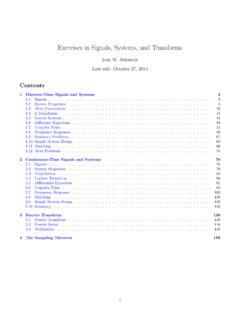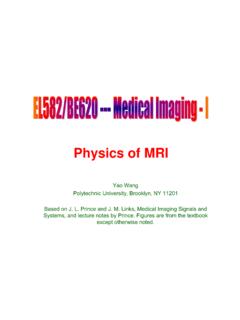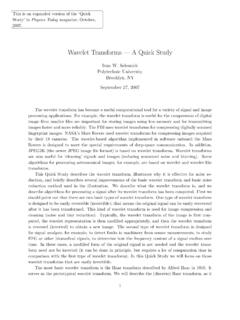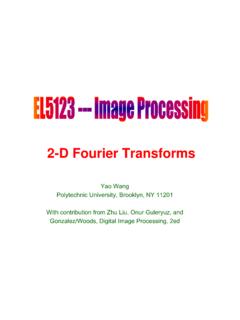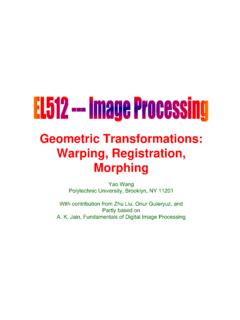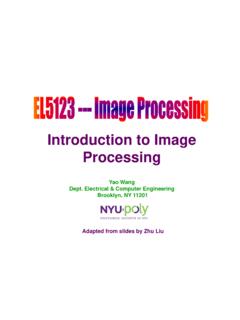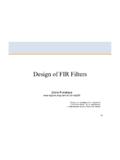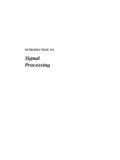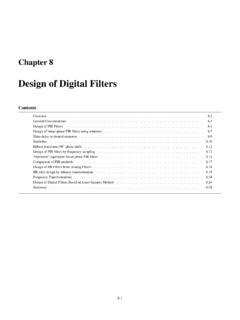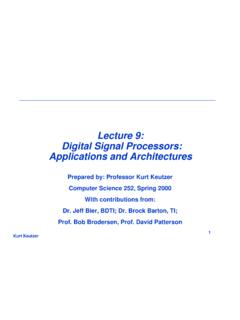Transcription of LINEAR-PHASE FIR FILTERS 1.The amplitude response 2.Why ...
1 LINEAR-PHASE FIR FILTERS1. The amplitude response2. Why LINEAR-PHASE ?3. The four types of LINEAR-PHASE FIR filter4. amplitude response characteristics5. Evaluating the amplitude response6. Zero locations of LINEAR-PHASE filters7. Automatic zeros8. design by DFT-based interpolation9. design by general interpolationI. SelesnickEL 713 Lecture Notes1 THE amplitude RESPONSEIf the real and imaginary parts ofHf( )are given byHf( ) =R( ) +j I( )the magnitude and phase are defined as|Hf( )|= R2( ) +I2( )p( ) = arctan(I( )R( ))so thatHf( ) =|Hf( )| ejp( ).With this definition,|Hf( )|is never negative andp( )is usuallydiscontinuous, but it can be very helpful to writeHf( )asHf( ) =A( ) ej ( )whereA( )can be positive and negative, and ( ) ( )is called theamplituderesponse.
2 The figure illustrates thedifference between|Hf( )|andA( ).I. SelesnickEL 713 Lecture Notes2 THE amplitude response (2) |H( )| = |A( )| / 4 2024 Phase{H( )} / ( ) / 20 15 10 50 ( ) / A LINEAR-PHASE phase filter is one for which the continuous phase ( )is ( ) =A( )ej ( )with ( ) = M + assume in the following that the impulse responseh(n)is SelesnickEL 713 Lecture Notes3 WHY LINEAR-PHASE ?If a discrete-time cosine signalx1(n) = cos( 1n+ 1)is processed through a discrete-time filter with frequency responseHf( ) =A( ) ej ( )then the output signal is given byy1(n) =A( 1) cos( 1n+ 1+ ( 1))ory1(n) =A( 1) cos( 1(n+ ( 1) 1)+ 1).
3 The LTI system has the effect of scaling the cosine signal and de-laying it by ( 1)/ does the system delay cosine signals withdifferent frequencies by the same amount?= ( ) =constant= ( ) =K = The phase is linearThe function ( )/ is called thephase delay. A linear phase filtertherefore has constant phase SelesnickEL 713 Lecture Notes4 WHY LINEAR-PHASE : EXAMPLEC onsider an discrete-time filter described by the difference equationy(n) = (n) + (n 1) (n 2) +x(n 3)+ (n 1) (n 2) + (n 3).When 1= , then the delay is ( 1)/ 1= delay is illustrated in the figure:2022242628303234363840 2 1 (n) (INPUT)2022242628303234363840 2 1 (n) (OUTPUT)Notice that the delay is fractional the discrete-time samples arenot exactly reproduced in the fractional delay can be interpreted in this case as a delay ofthe underlying continuous-time cosine SelesnickEL 713 Lecture Notes5 WHY LINEAR-PHASE .
4 EXAMPLE (2)Consider the same system given on the previous slide, but let uschange the frequency of the cosine 2= , then the delay is ( 2)/ 2= 2 1 (n) (INPUT)2022242628303234363840 2 1 (n) (OUTPUT)For this example, the delay depends on thefrequency, because this system does not havelinear SelesnickEL 713 Lecture Notes6 WHY LINEAR-PHASE : MOREFrom the previous slides, we see that a filter will delay differentfrequency components of a signal by the same amount if the filterhas linear phase (constant phase delay).In addition, when a narrow band signal (as in AM modulation) goesthrough a filter , the envelop will be delayed by thegroup delayorenvelop delayof the filter .
5 The amount by which the envelop isdelayed is independent of the carrier frequency only if the filter haslinear phase. (See page 214 in Mitra.)Also, in applications like image processing, FILTERS with non-linearphase can introduce artifacts that are visually SelesnickEL 713 Lecture Notes7 FOUR TYPES OF LINEAR-PHASE FIR FILTERSSec MitraLinear-phase FIR filter can be divided into four basic responseIsymmetriclength is oddIIsymmetriclength is evenIIIanti-symmetriclength is oddIVanti-symmetriclength is even024681012 I IMPULSE RESPONSE024681012 II IMPULSE RESPONSE024681012 IV IMPULSE RESPONSE024681012 III IMPULSE RESPONSEW henh(n)is nonzero for0 n N 1(the length of the impulseresponseh(n)isN)
6 , then the symmetry of the impulse responsecan be written ash(n) =h(N 1 n)and the anti-symmetry can be written ash(n) = h(N 1 n).I. SelesnickEL 713 Lecture Notes8 FOUR TYPES OF LINEAR-PHASE FIR FILTERSI mportant note: If the impulse responseh(n)iscomplex-valued,then to have LINEAR-PHASE the impulse response should beconjugate-symmetric SelesnickEL 713 Lecture Notes9 TYPE I: ODD-LENGTH SYMMETRICThe frequency response of a lengthN= 5 FIR Type I filter can bewritten as ( ) =h0+h1e j +h2e 2j +h1e 3j +h0e 4 (1)=e 2j (h0e2j +h1ej +h2+h1e j +h0e 2j )(2)=e 2j (h0(e2j +e 2j ) +h1(ej +e j ) +h2)(3)=e 2j (2h0cos (2 ) + 2h1cos ( ) +h2)(4)=A( )ej ( )(5)where ( ) = 2 , A( ) = 2h0cos (2 ) + 2h1cos ( ) + thatA( )is real-valued and can be both positive and general, for a Type I FIR FILTERS of lengthN:Hf( ) =A( )ej ( )A( ) =h(M) + 2M 1 n=0h(n) cos ((M n) ).
7 ( ) = M M=N SelesnickEL 713 Lecture Notes10 TYPE II: EVEN-LENGTH SYMMETRICThe frequency response of a lengthN= 4 FIR Type II filter canbe written as ( ) =h0+h1e j +h1e 2j +h0e 3j (6)=e 32j (h0e32j +h1e12j +h1e 12j +h0e 32j )(7)=e 32j (h0(e32j +e 32j ) +h1(e12j +e 12j ))(8)=e 32j (2h0cos(32 )+ 2h1cos(12 ))(9)=A( )ej ( )(10)where ( ) = 32 , A( ) = 2h0cos(32 )+ 2h1cos(12 ).In general, for a Type II FIR FILTERS of lengthN:Hf( ) =A( )ej ( )A( ) = 2N2 1 n=0h(n) cos ((M n) ) ( ) = M M=N SelesnickEL 713 Lecture Notes11 TYPE III: ODD-LENGTH ANTI-SYMMETRICThe frequency response of a lengthN= 5 FIR Type III filter canbe written as ( ) =h0+h1e j h1e 3j h0e 4 (11)=e 2j (h0e2j +h1ej h1e j h0e 2j )(12)=e 2j (h0(e2j e 2j ) +h1(ej e j ))(13)=e 2j (2jh0sin (2 ) + 2jh1sin ( ))(14)=e 2j j(2h0sin (2 ) + 2h1sin ( ))(15)=e 2j ej 2(2h0sin (2 ) + 2h1sin ( ))(16)=A( )ej ( )(17)where ( ) = 2 + 2, A( ) = 2h0sin (2 ) + 2h1sin ( ).
8 In general, for a Type III FIR FILTERS of lengthN:Hf( ) =A( )ej ( )A( ) = 2M 1 n=0h(n) sin ((M n) ) ( ) = M + 2M=N SelesnickEL 713 Lecture Notes12 TYPE IV: EVEN-LENGTH ANTI-SYMMETRICThe frequency response of a lengthN= 4 FIR Type IV filter canbe written as ( ) =h0+h1e j h1e 2j h0e 3j (18)=e 32j (h0e32j +h1e12j h1e 12j h0e 32j )(19)=e 32j (h0(e32j e 32j ) +h1(e12j e 12j ))(20)=e 32j (2jh0sin(32 )+ 2jh1sin(12 ))(21)=e 32j j(2h0sin(32 )+ 2h1sin(12 ))(22)=e 32j ej 2(2h0sin(32 )+ 2h1sin(12 ))(23)=A( )ej ( )(24)where ( ) = 32 + 2, A( ) = 2h0sin(32 )+ 2h1sin(12 ).In general, for a Type IV FIR FILTERS of lengthN:Hf( ) =A( )ej ( )A( ) = 2N2 1 n=0h(n) sin ((M n) ) ( ) = M + 2M=N SelesnickEL 713 Lecture Notes13 SUMMARY: amplitude FORMULASType ( )A( )I M h(M) + 2M 1 n=0h(n) cos ((M n) )II M 2N2 1 n=0h(n) cos ((M n) )III M + 22M 1 n=0h(n) sin ((M n) )IV M + 22N2 1 n=0h(n) sin ((M n) )M=N 12I.
9 SelesnickEL 713 Lecture Notes14 amplitude response CHARACTERISTICSTo analyze or design LINEAR-PHASE FIR FILTERS , we need to know thecharacteristics of the amplitude responseA( ).TypePropertiesA( )is even about = 0A( ) =A( )IA( )is even about = A( + ) =A( )A( )is periodic with2 A( + 2 ) =A( )A( )is even about = 0A( ) =A( )IIA( )is odd about = A( + ) = A( )A( )is periodic with4 A( + 4 ) =A( )A( )is odd about = 0A( ) = A( )IIIA( )is odd about = A( + ) = A( )A( )is periodic with2 A( + 2 ) =A( )A( )is odd about = 0A( ) = A( )IVA( )is even about = A( + ) =A( )A( )is periodic with4 A( + 4 ) =A( ) I A( ) / 1 II A( ) / 1 III A( ) / IV A( ) / I.
10 SelesnickEL 713 Lecture Notes15 EVALUATING THE amplitude RESPONSEThe frequency responseHf( )of an FIR filter can be evaluatedatLequally spaced frequencies between 0 and using the a causal FIR filter with an impulse responseh(n)of length-N, withN L. Samples of the frequency response of the filtercan be written asH(2 Lk)=N 1 n=0h(n)e j2 theL-point signal{g(n),0 n L 1}asg(n) ={h(n) 0 n N 10N n L (2 Lk)=G(k) =DFTL{g(n)}whereG(k)is theL-point DFT ofg(n).Types I and IISuppose the FIR filterh(n)is either a Type I or a Type II FIR we have from aboveHf( ) =A( )e jM orA( ) =Hf( )ejM.}

